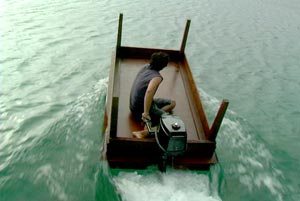Gone are the days when art raised political consciousness, or are they? Is it true that we live in a collective miasma of what the German philosopher Peter Sloterdijk calls enlightened false consciousness? Are we knowingly complicit? Sloterdijk's idea is that we participate in economies of oppression and inequity not so much by will but because we're part of a global corporate apparatus extended and reinforced in no small part by the good ole US of A. Most egregious of all, we do so with neither compunction nor the slightest thought of resistance or rebellion.

With this cynicism comes the desuetude of the belief that art can serve as a form of political agency — can make the viewer a political actor in the leftist-liberal sense of the term. At the same time, the rise of enlightened false consciousness marks the anticlimactic assimilation of the debate over art's autonomy. The back-and-forth over whether art must be disinterested or coded with a political message — autonomous from popular culture or imbedded within it — seems to have been consumed and digested, with the inessentials put out for trash. The academic elite of the architecture world continues to bang the drum of the field's necessary autonomy, if only to excuse themselves from their own enlightened false consciousness, but the art world seems little interested in the autonomy of art, in what Clement Greenberg enunciated through the rubric of "avant-garde and kitsch" in his 1939 essay and made explicit in the 1960 lecture later published as "Modernist Painting." For Greenberg, autonomy at least kept art from being the handmaiden of totalitarian propagandists and at most was a powerful if not empirical insurer of good form.

The work of artists from Andy Warhol to Martha Rosler, Thomas Hirschhorn to the video installation team of Jennifer Allora and Guillermo Calzadilla has made the demanded that art be autonomous, that it avoid any suggestion of political claim, null and void. These artists have made implicit and explicit political declamations, in and through pop culture, without flinching. And they have done so not so much because they are driven by belief, but sheer penchant for such expression. It's not as if anyone really believes that embedding work in popular culture or, more precisely, using art to say something political will ignite change. Artists nevertheless plug away in spite of the fact that change is unlikely. Autonomy has become an irrelevant debate.
That said, the two videos by Allora and Calzadilla now showing in Concentrations 50 at the Dallas Museum of Art are political without drubbing the viewer. If autonomy means nuance, subtlety and abstraction, then their work is "autonomous." There is no cudgeling in Allora and Calzadilla's exploration of the beautiful ugliness of globalization. Rather they coax the viewer along through nonlinear storytelling and the amazing hum of industrial white noise. As the curator Suzanne Weaver aptly put it, they "are not interested in political art. Instead they have found ways to make the political aesthetic." While we might have once been taken aback, almost shocked, by such a coupling, the aestheticizing of the political has become a contemporary necessity. Walter Benjamin warned of the dangers of aestheticizing the political, seeing it as a tool of fascism. But the tables have now turned, as we will literally find in Allora and Calzadilla's video, and today aestheticizing the political offers a powerful means of criticizing the corporate state, quietly entering the beast from within to fold it in upon itself through the poetic acts of a critical and observant mind.
Though shot in disparate geographies, off the coast of Puerto Rico and in China, the two films showing at the DMA comment on the creative destruction of modernization. Each shows the ravagings of global economic development. In Under Discussion (2005) the camera is trained above and alongside of Diego Zenón who is driving a boat made from an upside-down conference table jerry-rigged with an outboard motor. Zenón circles the table around the island of Vieques in an ingenious allegory for the topsy-turviness of global corporate and military power. Representative of a younger generation on Vieques, he is the son of a local fisherman who in the 1970s led a local body politic called the Fisherman's Association. An island six miles off the southeast corner of Puerto Rico taken over by the US Navy in 1941 for military training and to build a naval base, Vieques is a very real symbol of the folly of American empire. In 2003 the Navy gave ownership and management of the island to the US Fish and Wildlife Service. Viewers watch Zenón as he passes along the shore in images cut with aerial shots of bomb craters and the metal carcasses of military equipment, scars of the past American presence. These remnants of destruction contrast with the crystalline blue water underneath Zenón's table-boat. The video's descriptive and almost sociological nature is tempered by a disjunctive narrative of engine sounds and the slap and splash of ocean waves.

Amphibious (Login-Logout) deploys the hum of white noise to greater effect. Viewers hear boat engines throttling, hydraulic lifts for shipping containers clanking and the Pearl River gurgling while they follow six turtles balanced on a log placidly floating through the water. Though staged by Allora and Calzadilla, the turtles read like an opportune found object, a natural guide in the man-made over/underworld of the Pearl River Delta — the fount of one-third of the world's manufactured commercial goods. Showing shipping containers from Costco and Maersk, the video connects viewer to world, consumer to commodity fabrication. It offers a lesson in the art of extreme opposition. Sooty shantytown houseboats abut sooty cargo ships. Residential towers and tumbledown, tin-roofed houses stand side by side on the shoreline. The sun sets on a shipping container outpost, and the red lights of a rising global superpower flicker from the velvety, crepuscular backdrop of nightfall.
At a little over six minutes each, the videos are short, discursive narratives on the perverse un-nature of global development. They are pithy fictions wherein eyes, ears and the camera constitute a piecemeal narrator. The replacement of the traditional narrator's voice with a visual/aural composite serves to undercut the power of the centered human subject. It is a critique of old-fashioned humanism: to tell a story of globalization absent the conventional narrator's viewpoint is to deny that narrator his power. It is to maim the globalist by revoking the agency of voice and to empower others — a young man on an upside-down table-boat and six hapless turtles — by giving it.
1. Suzanne Weaver, Suzanne, Pamphlet for Concentrations 50 Jennifer Allora & Guillermo Calzadilla , exh. brochure (Dallas : , DMA , : 2006) , p . age 3 of unpaginated publication . 2.Weaver, p age . 1 of unpaginated publication .
Images courtesy Dallas Museum of Art.
Charissa N. Terranova is an Associate Proffessor at SMU and a Contributing Editor to Glasstire.



